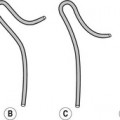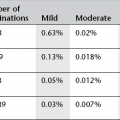Venous system
Peripheral venography
Intravenous (i.v.) peripheral venography is an invasive procedure requiring i.v. injection of contrast medium and the use of ionizing radiation. Marked limb swelling can result in failure to cannulate a vein which precludes use of the technique. False-negative results do occur. It is still considered the gold standard for diagnosis of deep venous thrombosis, but is now only very rarely performed.
Lower limb
Patient preparation
The leg should be elevated overnight to lessen oedema if leg swelling is severe.
Technique
1. The patient is supine and tilted 40° head up, to delay the transit time of the contrast medium.
2. A tourniquet is applied tightly just above the ankle to occlude the superficial venous system. The compression may also occlude the anterior tibial veins, and so their absence should not automatically be interpreted as due to venous thrombosis.
3. A 19G butterfly needle (smaller if necessary) is inserted into a vein on the dorsum of the foot. If the needle is too near the ankle, the contrast medium may bypass the deep veins and so give the impression of deep venous occlusion.
4. 40 ml of contrast medium is injected by hand. The first series of spot films is then taken.
5. A further 20 ml bolus is injected quickly whilst the patient performs a Valsalva manoeuvre to delay the transit of contrast medium into the upper thigh and pelvic veins. The patient is tilted quickly into a slightly head down position and the Valsalva manoeuvre is relaxed. Alternatively, if the patient is unable to comply, direct manual pressure over the femoral vein whilst the table is being tilted into the head-down position will achieve the same effect. Films are taken 2–3 s after releasing pressure.
6. At the end of the procedure the needle should be flushed with 0.9% saline to lessen the chance of phlebitis due to contrast medium.
Complications
Due to the contrast medium
1. As for the general complications of intravascular contrast media (Chapter 2)
2. Thrombophlebitis
3. Tissue necrosis due to extravasation of contrast medium. This is rare, but may occur in patients with peripheral ischaemia
4. Cardiac arrhythmia – more likely if the patient has pulmonary hypertension.
Upper limb
Technique
1. The patient is supine
2. An 18G butterfly needle is inserted into the median cubital vein at the elbow. The cephalic vein is not used, as this bypasses the axillary vein
3. Spot films are taken of the region of interest during a hand injection of 30 ml of contrast medium. Alternatively a digital subtraction angiographic run can be performed at 1 frame sec−1.
Central venography
Superior vena cavography
Technique
1. The patient is supine
2. 18G butterfly needles are inserted into the median antecubital vein of both arms
3. Hand injections of contrast medium 30 ml per side are made simultaneously, as rapidly as possible, by two operators. The injection is recorded by rapid serial radiography (see ‘Films’ below). The film sequence is commenced after about two-thirds of the contrast medium has been injected.
N.B. If the study is to demonstrate a congenital abnormality, or on the rare occasion that the opacification obtained by the above method is too poor, a 5-F catheter with side holes, introduced by the Seldinger technique, may be used.
Stay updated, free articles. Join our Telegram channel

Full access? Get Clinical Tree






